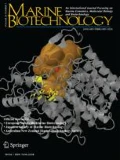Abstract
Preliminary characterization of a biosurfactant-producing Azotobacter chroococcum isolated from marine environment showed maximum biomass and biosurfactant production at 120 and 132 h, respectively, at pH 8.0, 38°C, and 30‰ salinity utilizing a 2% carbon substrate. It grew and produced biosurfactant on crude oil, waste motor lubricant oil, and peanut oil cake. Peanut oil cake gave the highest biosurfactant production (4.6 mg/mL) under fermentation conditions. The biosurfactant product emulsified waste motor lubricant oil, crude oil, diesel, kerosene, naphthalene, anthracene, and xylene. Preliminary characterization of the biosurfactant using biochemical, Fourier transform infrared spectroscopy, and mass spectral analysis indicated that the biosurfactant was a lipopeptide with percentage lipid and protein proportion of 31.3:68.7.




References
Banat IM, Makkar RS, Cameotra SS (2000) Potential commercial applications of microbial surfactants. Appl Microbiol Biotechnol 53:495–508
Bednarski W, Adamczak M, Tomasik J, Plaszczyk M (2004) Application of oil refinery waste in the biosynthesis of glycolipids by yeast. Bioresour Technol 95:15–18
Benson JH (1990) Microbial applications: a laboratory manual in general microbiology. WM.C. Brown, Dubuque
Das K, Mukherjee AK (2007) Comparison of lipopeptide biosurfactants production by Bacillus subtilis strains in submerged and solid state fermentation systems using a cheap carbon source: some industrial applications of biosurfactants. Process Biochem 42:1191–1199
Desai JD, Banat IM (1997) Microbial production of surfactants and their commercial potential. Microbiol Mol Biol Rev 61:47–64
Dubois M, Gilles KA, Hamilton JK, Rebers PA, Smith F (1956) Colorimetric method for determination of sugars and related substances. Anal Chem 28:350–356
Fernandez-Linares L, Acquaviva M, Bertrand J-C, Gauthier M (1996) Effect of sodium chloride concentration on growth and degradation of eicosane by marine halotolerent bacterium Marinobacter hydrocarbonoclastieus. Appl Microbiol 19:113–121
Folch JM, Lees M, Stanly HS (1956) A simple method for the isolation and quantification of total lipids from animal tissues. J Biol Chem 226:497–509
Georgiou G, Lin SC, Sharma MM (1992) Surface-active compounds from microorganism. Biotechnology 10:60–65
Goldman S, Shabtai Y, Rubinovitz C, Rosenberg E, Gutnick DL (1982) Emulsan in Acinetobacter calcoaceticus RAG-I: distribution of cell-free and cell associated cross-reacting materials. Appl Environ Microbiol 44:165–170
Kalinovskaya N, Kuznetsova T, Rashkes Ya, Mil’grom Yu, Mil’grom E, Willis R, Wood A, Kurtz H, Carabedian C, Murphy P, Elyakov G (1995) Surfactin-like structures of five cyclic despsipeptises from the marine isolates of Bacillus pumilus. Russ Chem Bull 44:951–955 (English translation)
Kuiper I, Lagendijk EL, Pickford R, Derrick JP, Lamers GEM, Thomas-Oates JE, Lugtenberg BJJ, Bloemberg GV (2004) Characterization of two Pseudomonas putida lipopeptide biosurfactants, putisolvin I and II, which inhibit biofilm formation and break down existing biofilms. Mol Microbiol 51:97–113
Li Z-Y, Lang S, Wagner F, Witte L, Wary V (1984) Formation and identification of interfacial-active glycolipids from resting microbial cells. Appl Environ Microbiol 48:610–617
Lowry OH, Rosebrough NJ, Farr AL, Randall RJ (1951) Protein measurement with the Folin phenol reagent. J Biol Chem 193:265–275
Nitschke M, Pastore GM (2004) Biosurfactant production by Bacillus subtilis using cassava processing effluent. Appl Biochem Biotechnol 112:163–172
Onwurah INE (1999) Role of diazotropic bacteria in the bioremediation of crude oil-polluted soil. J Chem Technol Biotechnol 74:957–964
Page WJ (1986) Sodium-dependent growth of Azotobactor chroococcum. Appl Environ Microbiol 51:510–514
Perfumo A, Banat IM, Canganella F, Marchant R (2006) Rhamnolipid production by a novel thermotolerant hydrocarbon-degrading Pseudomonas aeruginosa AP02-1. Appl Microbiol Biotechnol 72:132–138
Rahaman KSM, Banat IM, Thahira J, Thayumanavan T, Lakshmanaperumalsamy P (2002a) Bioremediation of gasoline contaminated soil by bacterial consortium with poultry litter, coir pith and rhamnolipid biosurfactant. Bioresour Technol 81:25–32
Rahaman KSM, Rahman TJ, McClean S, Marchant R, Banat IM (2002b) Rhamnolipid biosurfactant production by strains of Pseudomonas aeruginosa using low-cost raw materials. Biotechnol Prog 18:1277–1281
Razafindralambo H, Paquot M, Baniel A, Popineau Y, Hbid C, Jacques P, Thonart P (1996) Foaming properties of surfactin, a lipopeptide biosurfactant from Bacillus subtilis. J Am Oil Chem Soc 73:149–151
Rosenberg E, Zuckerberg A, Rubinovitz C, Gutnick DL (1979) Emulsifier of Arthrobacter RAG-I: isolation and emulsifying properties. Appl Environ Microbiol 37:402–408
Thavasi R, Jayalakshmi S, Balasubramanian T, Banat IM (2006) Biodegradation of crude oil by nitrogen fixing marine bacteria Azotobacter chroococcum. Res J Microbiol 1:401–408
Thavasi R, Jayalakshmi S, Balasubramanian T, Banat IM (2007) Biosurfactant production by Corynebacterium kutscheri from waste motor lubricant oil and peanut oil cake. Lett Appl Microbiol 45:686–691
Vasileva-Tonkova E, Gesheva V (2005) Glycolipids produced by Antarctic Nocardioides sp. during growth on n-paraffin. Process Biochem 40:2387–2391
Velikonja J, Kosaric N (1993) Biosurfactant in food application. In: Kosaric N (ed) Biosurfactants: production, properties, applications. Marcel Dekker, New York
Zajic JE, Gignard H, Gerson DF (1977) Properties and biodegradation of a bioemulsifier from Corynebacterium hydrocarbonoclasticus. Biotechnol Bioeng 91:1303–1320
Acknowledgments
We thank the authorities of Annamalai University for providing the facilities and DOD and CSIR, Government of India for financial support.
Author information
Authors and Affiliations
Corresponding author
Rights and permissions
About this article
Cite this article
Thavasi, R., Subramanyam Nambaru, V.R.M., Jayalakshmi, S. et al. Biosurfactant Production by Azotobacter chroococcum Isolated from the Marine Environment. Mar Biotechnol 11, 551–556 (2009). https://doi.org/10.1007/s10126-008-9162-1
Received:
Accepted:
Published:
Issue Date:
DOI: https://doi.org/10.1007/s10126-008-9162-1

